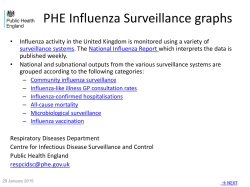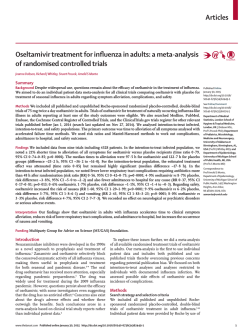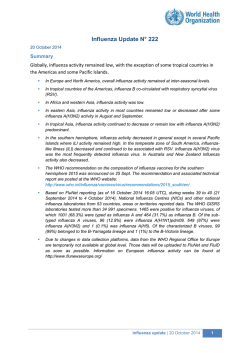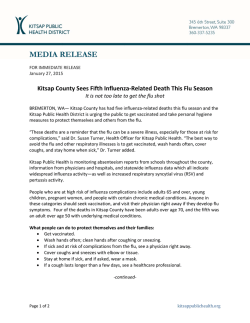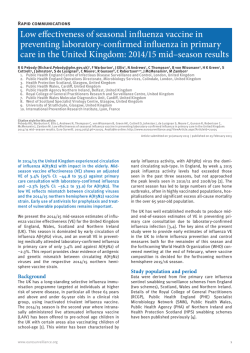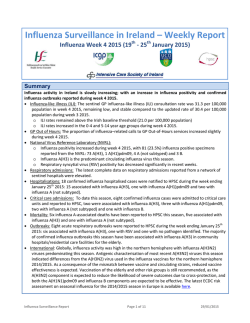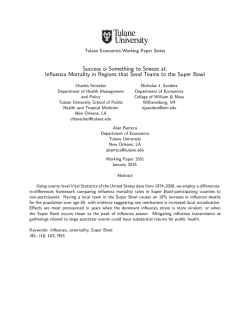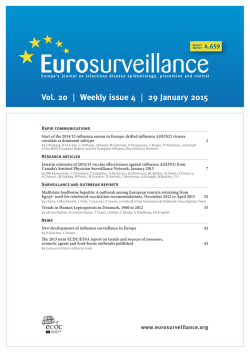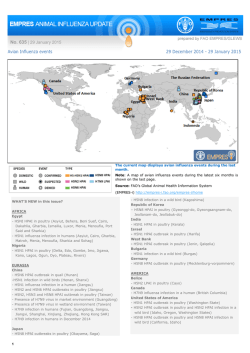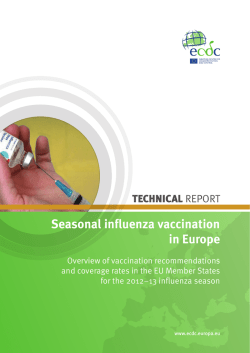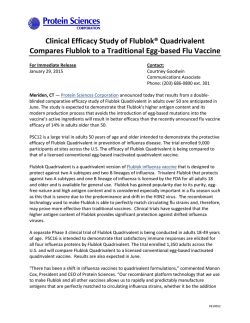
New Treatment Strategies for Influenza
Carpio-Orantes. Int J Respir Pulm Med 2015, 2:1 International Journal of Respiratory and Pulmonary Medicine Mini Review: Open Access New Treatment Strategies for Influenza Luis del Carpio-Orantes* Department of Internal Medicine, General Hospital 71, Mexican Institute of Social Security, Mexico *Corresponding author: Dr. Luis del Carpio-Orantes, Internist Physicians, Department of Internal Medicine, General Hospital 71, Mexican Institute of Social Security, Veracruz, Mexico, Tel: 01 22 92 23 70 32, E-mail: [email protected] Keywords Amantadine, Oseltamivir, Ribavirin, Laninamivir, Peramivir After the pandemic influenza H1N1 2009, there are many lessons learned regarding the diagnosis and treatment of patients affected by this virus. However, there have also been a number of contingencies that have greater concern to the world population, mainly by new types as infectious outbreaks, as well as the report of virus mutations that confer resistance to common treatment widely used. For new outbreaks have resulted in a new calamity , after the A (H1N1) pdm09 , mainly mentioned the influenza A H3N2, H5N1, and more recently isolated, from avian influenza H7N9 in China, identifying in each of these types, mutations that confer resistance to conventional treatment with anti M2 (amantadine and rimantadine) and neuraminidase inhibitors even. In this last regard, a mutation (H275Y) that conferred resistance to oseltamivir, which increased virulence and contagiousness to influenza virus was identified. There are other even more disturbing, as the H274Y mutation (which confers resistance to Peramivir and oseltamivir , but not Zanamivir) and other minor mutations (E119, D198, I222, R292 and N294) that reduce sensitivity to neuraminidase inhibitors. Fortunately, already working on new antivirals and new established guidelines, for a best strategy against possible future pandemics of influenza in incubation, and new resistant strains to conventional treatments [1-3]. Currently it is well known that drugs known as anti M2, amantadine and rimantadine , are effective only in influenza A common, being ineffective in H1N1 and other current pathogenic strains. On the other hand, we have to neuraminidase inhibitors, of which most common and representative is oseltamivir, however, as previously said there are reports of resistance to that drug, fortunately taking other similar options that pharmacological group, being the Zanamivir (inhaled neuraminidase inhibitor), used as the alternative to oseltamivir therapy in most countries, but with the drawback of generating bronchial spasm, which makes its use be reserved. Since the advent of severe cases, began investigating new drugs of this group , highlighting Peramivir (inhibitor of neuraminidase intravenous) and the Laninamivir (inhibitor of neuraminidase inhaled, long-acting, and therefore, single dose), and taking ClinMed International Library experience in the management of these drugs in different pathogenic H1N1 strains (H3N2 , H5N1) with encouraging results , and without the inconvenience of bronchospasm other inhaled drug [4-7]. Other drug classes with promising results have emerged, especially when combined with inhibitors of neuraminidase, like the Favipiravir (an inhibitor of the viral RNA polymerase), the same way a drug, more experienced in their use, to be suitable for many viruses, it has been begun to use, this being the Ribavirin, an inhibitor of RNA polymerase and DNA. Speaking of combination regimens, which it seems, is the future in the treatment of resistant influenza, or the emergence of new pathogenic strains, a triple scheme antiviral drug (TCAD), which currently have studied two schemes, that seem to have mentioned control effectiveness oseltamivir resistant influenza and new pathogenic strains reported recently (H7N9), which are: Amantadine, Oseltamivir and Ribavirin (Demonstrating effectiveness in H1N1 strains resistant to oseltamivir alone and H5N1; further corroborate that the synergy between amantadine and oseltamivir, combined with Ribavirin was very effective to control strains, even 72 hrs after starting treatment) [8-10]. Oseltamivir, Peramivir and Favipiravir (Used in the 3 strains of H7N9, which were isolated in China, which were resistant to amantadine and rimantadine) [11,12]. In conclusion we believe that despite having new strains of influenza and increasingly virulent, favorecidad by point mutations of the virus, there is also research on the pharmacological area which ensures to combat sign of this is that, in this winter, not reported product worldwide outbreak strain conferred by any pandemic danger. Also that although many countries in Latin America, Africa and Asia, do not have all commented medications, have the basic, even being able to achieve a combination of triple scheme as suggested, being encouraged by the combination of amantadine, oseltamivir and ribavirin , for its facililidad obtained and which has been used in more virulent than H1N1 strains. Citation: Carpio-Orantes LD (2015) New Treatment Strategies for Influenza. Int J Respir Pulm Med 2:012 Received: December 07, 2014: Accepted: January 24, 2015: Published: January 28, 2015 Copyright: © 2015 Carpio-Orantes LD. This is an open-access article distributed under the terms of the Creative Commons Attribution License, which permits unrestricted use, distribution, and reproduction in any medium, provided the original author and source are credited. It is recommended to remain vigilant regarding epidemiological outbreaks and try to bring them down promptly to prevent pandemics that could ravage humanity in the future, favored by climate change and global pollution. References 1. McKimm-Breschkin JL (2013) Influenza neuraminidase inhibitors: antiviral action and mechanisms of resistance. Influenza Other Respir Viruses 7: 2536. and peramivir--for treatment of influenza A(H3N2) and A(H1N1)pdm09 infection: an observational study in the 2010-2011 influenza season in Japan. J Infect Chemother 18: 858-864. 7. Govorkova EA (2013) Consequences of resistance: in vitro fitness, in vivo infectivity, and transmissibility of oseltamivir-resistant influenza A viruses. Influenza Other Respir Viruses 7: 50-57. 8. Nguyen JT, Hoopes JD, Le MH, Smee DF, Patick AK, et al. (2010) Triple combination of amantadine, ribavirin, and oseltamivir is highly active and synergistic against drug resistant influenza virus strains in vitro. PLoS One 5: e9332. 2. Hurt AC, Holien JK, Parker MW, Barr IG (2009) Oseltamivir resistance and the H274Y neuraminidase mutation in seasonal, pandemic and highly pathogenic influenza viruses. Drugs 69: 2523-2531. 9. Hoopes JD, Driebe EM, Kelley E, Engelthaler DM, Keim PS, et al. (2011) Triple combination antiviral drug (TCAD) composed of amantadine, oseltamivir, and ribavirin impedes the selection of drug-resistant influenza A virus. PLoS One 6: e29778. 3. Tarbet EB, Maekawa M, Furuta Y, Babu YS, Morrey JD, et al. (2012) Combinations of favipiravir and peramivir for the treatment of pandemic influenza A/California/04/2009 (H1N1) virus infections in mice. Antiviral Res 94: 103-110. 10.Nguyen JT, Smee DF, Barnard DL, Julander JG, Gross M, et al. (2012) Efficacy of combined therapy with amantadine, oseltamivir, and ribavirin in vivo against susceptible and amantadine-resistant influenza A viruses. PLoS One 7: e31006. 4. Ikematsu H, Kawai N (2013) Laninamivir octanoate: a new long-acting neuraminidase inhibitor for the treatment of influenza. Influenza Other Respir Viruses 7: 25-36. 11.Kang SJ, Park KH, Kee SJ, Shin JH, Jung SI, et al. (2013) Virological clearance rate of high-dose oseltamivir or triple-combination antiviral therapy in complicated 2009 pandemic influenza A (H1N1) infection. Jpn J Infect Dis 66: 425-427. 5. Watanabe A, Chang SC, Kim MJ, Chu DW, Ohashi Y, et al. (2010) Longacting neuraminidase inhibitor laninamivir octanoate versus oseltamivir for treatment of influenza: A double-blind, randomized, noninferiority clinical trial. Clin Infect Dis 51: 1167-1175. 6. Shobugawa Y, Saito R, Sato I, Kawashima T, Dapat C, et al. (2012) Clinical effectiveness of neuraminidase inhibitors--oseltamivir, zanamivir, laninamivir, Carpio-Orantes. Int J Respir Pulm Med 2015, 2:1 12.Cao RY, Xiao JH, Cao B, Li S, Kumaki Y, et al. (2013) Inhibition of novel reassortant avian influenza H7N9 virus infection in vitro with three antiviral drugs, oseltamivir, peramivir and favipiravir. Antivir Chem Chemother 23: 237-240. • Page 2 of 2 •
© Copyright 2024
